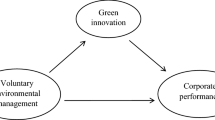Abstract
Obtaining environmental certification (such as the ISO-14,001) has become a status symbol for adopting greener practices for the corporate sector in emerging economies. Such certification can help improve the global visibility of firms and is mandated in international trade. This paper attempts to examine the impact of such certifications on technical efficiency of firms belonging to the manufacturing sector in India. In analyzing the impact of ISO Certification on technical efficiency, this paper uses data from the CMIE Prowess from 2007 to 2012. In the first step, the paper estimates technical efficiency for the sample firms and then examines the determinants of inter-firm differences in technical efficiency using firm specific characteristics. The results of this study conclude that there are substantial inter-firm differences in technical efficiency and they are systematically different based on firm age, firm size, debt capital, MNE affiliation, and ISO certification. ISO certification, especially maintaining the standards associated with it, turned out to be an important factor in making the firms achieve higher technical efficiency. In addition, the results of this study also confirm that firms that are ISO certified and doing R&D are better off in technical efficiency as compared to others.

Similar content being viewed by others
Notes
According to the Porter hypothesis, strict environmental regulations can induce efficiency and encourage innovations that help improve commercial competitiveness. The hypothesis was formulated by Michael Porter in 1995. The hypothesis suggests that strict environmental regulation triggers the discovery and introduction of cleaner technologies and environmental improvements, the innovation effect, making production processes and products more efficient. The cost savings that can be achieved are sufficient to overcompensate for both the compliance costs directly attributed to new regulations and the innovation costs. In the first mover advantage, a company is able to exploit innovation by learning curve effects or patenting and attains a dominating competitive position compared to companies in countries where environmental regulations were enforced much later.
According to Jaffe et al. (2002), “A firm can innovate without ever inventing, if it identifies a previously existing technical idea that was never commercialized, and brings a product or process based on that idea to the market”.
References
Ashford AA, Heaton GR (1981) Regulation and technological innovation in the chemical industry. Law Contemp Probl 46(3):109–157
Bellas AS (1998) Empirical evidence of advances in Scrubber Technology. Resour Energy 20(4):327–343
Brunnermeier SB, Cohen MA (2003) Determinants of Environmental innovation in US Manufacturing Industries. J Environ Econ Manag 45(2):278–293
Coelli TJ (1996) A guide to frontier version 4.1: a computer program for stochastic frontier production and cost function estimation. Working paper no. 07. C, University of New England, Armidale, Australia
Feng H, Rong C (2007) Innovation, firm efficiency and firm value: firm level evidence in Japanese Electricity machinery industry. In: Wireless Communications, Networking and Mobile Computing, international conference on Sept. 21–25, pp. 4217–4220
Goldar BN, Renganathan VS, Banga R (2004) Ownership and efficiency in engineering firms: 1990–91 to 1999–2000. Econ Polit Wkly 39(5):441–447
Huang CJ, Liu CJ (2005) Exploration for the relationship between innovation, IT and performance. J Intellect Cap 6(2):136–159
Jaffe AB, Palmer K (1996) Environmental Regulation and Innovation: A Panel Data Study. In: Working Paper. National Bureau of Economic Research, Cambridge
Jaffe AB, Newell RG, Stavins RN (2002). Environmental policy and technological change. Environ Resour EconI, Vol. 22(1–2), pp. 41–69
Johnstone N, Hascic I, Popp D (2008) Renewable energy policies and technological innovation: evidence based on patent counts. In: Working paper. National Bureau of Economic Research, Cambridge
Lange I, Bellas A (2005) Technological change for sulfur dioxide scrubbers under market-based regulation. Land Econ 81(4):546–556
Lyon TP (1996) Regulatory hindsight review and innovation by electric utilities. J Regul Econ 7(3):233–254
Majumdar SK, Marcus AA (2001) Rules versus discretion: the productivity of flexible regulation. Acad Manag J 44(1):170–179
Marcus AA (1988) Implementing induced innovations: a comparison of rule-bound and autonomous approaches. Acad Manag J 31(2):235–256
Pickman HA (1998) The effect of Environmental regulation on Environmental innovation. Bus Strateg Environ 7(4):223–233
Point of view: National Manufacturing Policy, (2012) https://www.pwc.in/en_IN/in/assets/pdfs/industries/industrial-manufacturing/national-manufacturing-policy-pov.pdf
Popp D (2003) Pollution control innovations and the Clean Air Act of 1990. Journal of Policy Analysis And Management 22(4):641–660
Popp D (2006) International innovation and diffusion of air pollution control technologies: the effects of NOx and SO2 regulation in the US, Japan, and Germany. J Environ Econ Manag 51(1):46–71
Schumpeter J (1942) Capitalism, Socialism and Democracy. Harper, New York
Sickes RC, Streitweiser ML (1991) Technical inefficiency and productive decline in the U.S. interstate natural gas pipeline industry under the natural gas policy act, Discussion Paper
Taylor MR, Rubin ES, Hounshell DA (2005) Control of SO2 emissions from power plants: a case of induced technological innovation in the U.S. Technol Forecast Soc Chang 72(6):697–718
Whitelaw, K (2004) ISO 14001 Environmental systems handbook. Second edition, Elsevier Butterworth-Heinemann, Linacre House, Jordan Hill, Oxford OX2 8DP, 30 Corporate Drive, Burlington, MA 01803, ISBN 0 7506 4843 0
Acknowledgments
We are grateful to Prof. N. S. Siddharthan, Prof. Bino Paul and Prof. B. N. Goldar for their comments and suggestions during the Ninth Annual Conference of Knowledge Forum organized at NIAS Bangalore during October 27-29, 2014. Thanks are due, to the participants of the conference for the insightful discussions during the conference. We are also thankful to the anonymous reviewers for the comments and suggestions in the earlier draft of the paper.
Author information
Authors and Affiliations
Corresponding author
Rights and permissions
About this article
Cite this article
Sahu, S.K., Narayanan, K. Environmental Certification and Technical Efficiency: A Study of Manufacturing Firms in India. J Ind Compet Trade 16, 191–207 (2016). https://doi.org/10.1007/s10842-015-0213-9
Received:
Revised:
Accepted:
Published:
Issue Date:
DOI: https://doi.org/10.1007/s10842-015-0213-9




